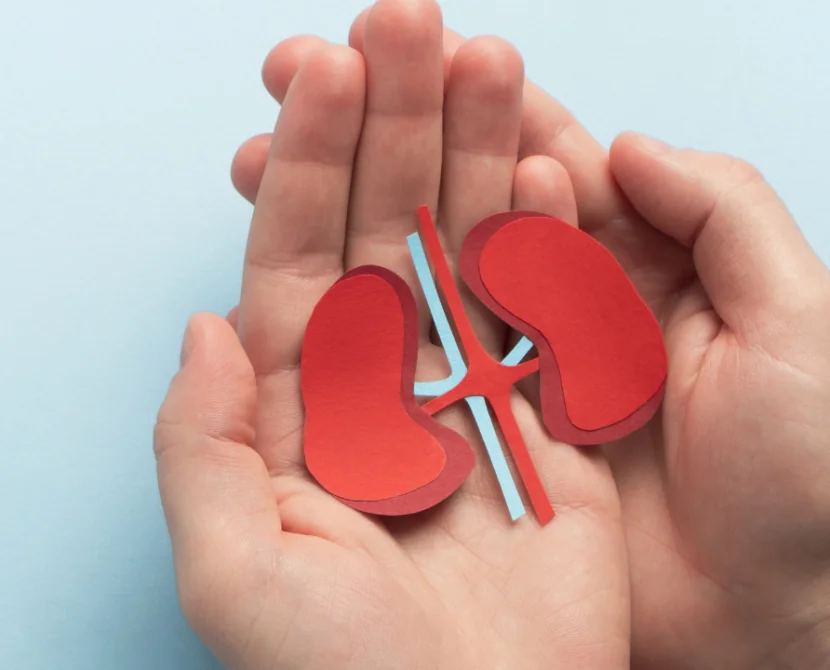The Link Between Diabetes and the Kidneys

We are pleased to present the first article in a three-part series sponsored by The BI-Lilly Alliance and written by Amy Hess Fischl, MS, RD, LDN, BC-ADM, CDCES. Content is provided for information only; please consult with your healthcare provider before making changes to your diabetes management.
I am not going to lie to you; these next few sentences are not pretty. But they need to be said. Kidney disease among people with diabetes has become more common over the years. The International Diabetes Federation estimates that 537 million people were living with diabetes in 2021, with an expected increase to 784 million by the year 2045 (1). The prevalence of kidney disease among people with diabetes is >25%, and it has been estimated that 40% of people with diabetes develop CKD during their lifetime (2). In the U.S., one of every five adults with diabetes is not aware of their diagnosis (3). Awareness of kidney disease is even lower, with nine of ten individuals unaware of having kidney issues, including two out of five having severe kidney disease (4,5). In addition, both diabetes and kidney disease affect racial and ethnic minorities and older adults more often. Lack of screening, diagnosis, and awareness impacts preventing kidney disease. Now, why would I want to lay out this bucket of bummer balls to you? Because it is very clear that prevention is possible, but it takes YOU to be empowered to work with your healthcare team to do what is best for your overall kidney health. This first article, in a series of three, is meant to lay things out to get you thinking about all that you can do to stay ahead of kidney disease.
The link between diabetes and kidneys
When glucose and blood pressure are not managed within the current recommendations (more on this a little later), it can put more pressure on the blood vessels and lead to damage. This happens over years of consistently elevated glucose and blood pressure which can affect:
- Blood vessels
- Eyes
- Feet
- Heart
- Kidneys
- Nerves
Diabetes can harm the kidneys specifically by causing damage to the small blood vessels in the kidneys. The filtering units of the kidney are filled with these tiny blood vessels. Over time, high glucose in the blood can cause these vessels to become narrow, clogged and damaged. Without enough blood, the kidneys become damaged as well and protein passes through these filters and ends up in the urine where it is not supposed to be.
Diabetes can also cause damage to the nerves in your body. Nerves carry messages between your brain and all other parts of your body, including your bladder. They let your brain know when your bladder is full. But if the nerves of the bladder are damaged, you may not be able to feel when your bladder is full. The pressure from a full bladder can damage your kidneys.
If urine stays in your bladder for a long time, you may get a urinary tract infection. This is because of bacteria, which can grow very quickly in the urine when there are consistently elevated glucose levels. Most often these infections affect the bladder, but they can sometimes spread to the kidneys if the infection is not treated.
Risk factors
As mentioned above, 40% of people with diabetes may get kidney disease.
Certain groups may have a higher risk of getting kidney disease than others. Your risk may be greater if you:
- Are over 60 years of age
- Have high blood pressure
- Have a family member who has kidney failure, diabetes, high pressure
- Are African American, Hispanic, Asian, Pacific Islander or American Indian
Prevention and self-management
Many people with diabetes do not get kidney disease or kidney failure. Have an open and honest ongoing conversation with to your healthcare team about your chances of getting kidney disease. The best way to prevent getting kidney disease from diabetes is to:
- Manage your blood glucose level – it is recommended that most people maintain an A1C (overall average glucose over the past 8-12 weeks) under 7%; maintain pre-meal glucose readings <130 mg/dL; 1 hour after meals<180 mg/dL; 2 hours after meals <140 mg/dL. Remember, these are general guidelines for most people with diabetes. Work with your healthcare team to individualize goals that are right for you. (6)
- Keep blood pressure within recommended guidelines – it depends on who you talk to, but most kidney specialists tend to recommend a blood pressure goal <120/80 mm Hg. Talk with your healthcare team about your goal. (6)
- Ask your healthcare team to test you for kidney disease at least once each year – the two tests that should be done every year include:
- Urine albumin to creatinine ratio: this urine test shows kidney health by detecting protein is in the urine
- Estimated glomerular filtration rate: this blood test measure how well the kidneys are functioning
- Take medicines as directed to help manage blood glucose, cholesterol, and blood pressure if your healthcare team orders them for you
- Follow healthy eating guidelines for overall diabetes health
- Move more – goals are to be active at least 150 minutes every week
- Limit or eliminate alcohol
- Do not smoke
- See your healthcare team as often it is recommended – typically, you should see your team every 3-6 months
- There are also recommendations of how often you should receive diabetes self-management education and support (DSMES) – also known as diabetes education. The 4 Critical Times for (DSMES) include:
- At Diagnosis
- Annually
- If Complicating Factors Develop
- When Transitions in Life or Care Occur (7)
- Use the benefits that are available to you – typically, 2 hours of DSMES is a covered benefit every year to individualize your needs and goals.
- To find a certified diabetes care and education specialist or an accredited/recognized program you can use the following resources:
- There are also recommendations of how often you should receive diabetes self-management education and support (DSMES) – also known as diabetes education. The 4 Critical Times for (DSMES) include:
This information is not meant to scare you. It is meant to “light a fire”, spark conversation with your healthcare team and empower you to move forward in this journey of preventing kidney disease.
Living with type 2 diabetes or high blood pressure? You could have kidney disease without even knowing it. It takes 2 – you and a healthcare professional – to detect kidney disease and take steps to help reduce serious complications. Click here to read more and request the test.
References:
- International Diabetes Federation. World Atlas – www.idf.org
- Afkarian M, Zelnick LR, Hall YN, et al. Clinical manifestations of kidney disease among US adults with diabetes, 1988-2014. JAMA 2016;316:602–610.
- Centers for Disease Control and Prevention. National Diabetes Statistics Report. Atlanta, GA, Centers for Disease Control and Prevention. https://www.cdc.gov/diabetes/data/statistics-report/index.html. Accessed November 8, 2023.
- United States Renal Data System. 2023 USRDS Annual Data Report: Epidemiology of Kidney Disease in the United States. Bethesda, MD, National Institutes of Health, National Institute of Diabetes and Digestive and Kidney Diseases, 2023.
- Chu CD, McCulloch CE, Banerjee T, et al.; Centers for Disease Control and Prevention Chronic Kidney Disease Surveillance Team. CKD awareness among US adults by future risk of kidney failure. Am J Kidney Dis 2020;76:174–183.
- Alicic R, Nicholas SB. Diabetic Kidney Disease Back in Focus: Management Field Guide for Healthcare Professionals in the 21st Century. Mayo Clin Proc. 2022;97(10):1904-1919.
- Davis J, Hess Fischl A, Beck J et al. 2022 National Standards for Diabetes Self-Management Education and Support Diabetes Care 2022;45:484–494 | https://doi.org/10.2337/dc21-2396
Amy Hess Fischl, MS, RD, LDN, BC-ADM, CDCES, is an advanced practice dietitian and diabetes care and education specialist at the University of Chicago within the departments of pediatric and adult endocrinology. She speaks internationally on all diabetes topics, especially meal plan options for type 1 diabetes, insulin pumps,and continuous glucose monitors. She is actively involved in the American Diabetes Association, the Academy of Diabetes Care and Education Specialists, and the Academy of Nutrition and Dietetics, as well as several international groups for diabetes and pre-diabetes. She was named 2018 IL AADE Diabetes Educator of the Year and also received the 2018 Pan Arab Congress on Diabetes Award of Excellence for her contributions to diabetes care and education. Her dream vacation always includes diving with sharks.





